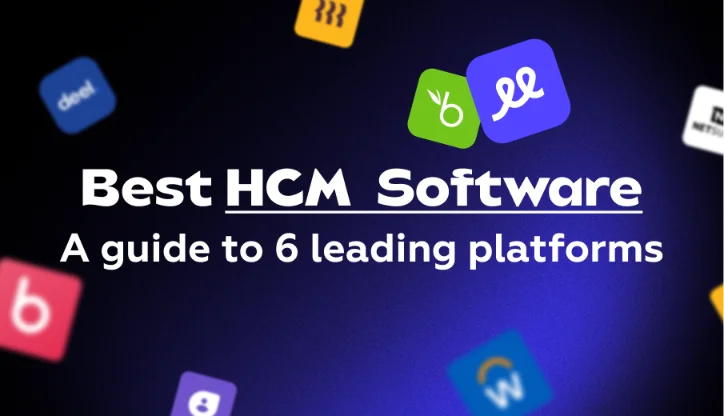The Best HCM Software: A Guide to 6 Leading Platforms

In a world where people are not just resources but the core capital of a business, the way we think about and work with them is also changing. Today’s article builds on this shift in mindset and focuses on the tools that help bring this strategy to life: modern HCM software that allows companies to see employees not just as a “resource,” but as an asset with growth potential. At a time when technology and data play an increasingly critical role, choosing the right HCM software is one of the most important decisions for any HR or People & Culture team.
This guide will explore the leading platforms in the human capital management space, highlighting which solutions are best suited for different needs—from simple tools for smaller companies to robust HCM systems for global organizations. We will focus on six widely used HCM software systems: Sloneek, HiBob, BambooHR, Dayforce, SAP SuccessFactors, and ADP Workforce Now. For each, we will outline its strengths, potential drawbacks, and ideal user.
How to Choose the Best HCM System for Your Business
Modern Human Capital Management Software should do much more than just basic personnel administration. In addition to managing employee data, time and attendance tracking, and payroll processing, companies today expect tools for talent management, employee training, performance management, reporting, and People Analytics. The ideal human capital management system is also a cloud-based HCM solution (SaaS), easily integrates with other business applications via integration software, offers a friendly user interface, and ensures global compliance. An effective HCM platform automates routine HR functions, freeing up HR teams to focus on more strategic initiatives.
The HCM software market is filled with options, so it’s vital to choose a system with robust HRIS features that align with your company’s HCM strategy. This includes everything from candidate sourcing and employee onboarding to performance reviews and succession planning. Look for HCM solutions that offer real-time dashboards, employee self-service portals, and mobile accessibility to enhance the employee experience.
Sloneek
Sloneek is an HCM software designed primarily for small and medium-sized businesses. It features a Core Human Resources system with several additional HR modules that clients can utilize.
|
Advantages |
Disadvantages |
|---|---|
|
The main advantage of Sloneek is its simplicity and complete coverage of the employee lifecycle—from talent acquisition and employee onboarding to offboarding, including performance management, AI-powered surveys, and competency assessments. It also offers clear reports and analytics that help HR teams with strategic workforce planning. It is ideal for small and medium-sized companies that want a straightforward, affordable, and localized solution without a complex implementation process. |
For very large organizations with an international presence, Sloneek might face limitations in advanced features or integration with global HCM systems . |
HiBob
HiBob is a modern HCM platform that helps companies increase productivity, employee engagement, and retention through tools for employee onboarding, payroll management, performance evaluation, analytics, and communication in a social-network-like environment.
|
Advantages |
Disadvantages |
|---|---|
|
This HCM system is designed for fast-growing companies that want to build an engaged company culture and improve the employee experience. It offers an attractive user interface, powerful analytics, and the ability to track performance, development, and employee satisfaction. HiBob is a fully cloud HCM software, intuitive, and easily scalable. |
A higher price point and the need to customize some modules for local markets might be a drawback for smaller organizations. Their customer support is well-regarded. |
BambooHR
BambooHR is a user-friendly HR platform with human capital management features that consolidates payroll, time and attendance, benefits management, and performance reviews into a single system, helping companies enhance the employee experience. It stands out among HCM companies for its focus on usability.
|
Advantages |
Disadvantages |
|---|---|
|
By automating key HR processes, conducting satisfaction surveys, and providing clear analytics dashboards, BambooHR enables teams to better understand employee needs and support their development. Its HRM software capabilities make it a strong contender. |
The pricing may be too high for smaller businesses. The core plan does not include features like performance management, which is only available in the Pro pricing model. |
Dayforce
Dayforce (formerly known as Ceridian) is a robust HCM platform that combines payroll processing, benefits enrollment, talent management, and workforce management into a single, global human capital management system. It’s one of the leading human capital management solutions for large enterprises.
|
Advantages |
Disadvantages |
|---|---|
|
Using AI-powered tools, Dayforce automates processes, offers predictive insight for labor forecasting, and provides managers and employees with clear workforce data for effective planning, development, and team management. As a comprehensive human capital management solution, it is designed for large companies with a global footprint. Its workforce scheduling and labor cost tracking features are particularly strong. |
Implementation can be more time-consuming and expensive, requiring solid project management. |
SAP SuccessFactors
SAP SuccessFactors is one of the most well-known HCM systems on the market, offering a wide range of HR modules—from talent acquisition and employee training to performance evaluation and workforce planning & analytics. It’s designed for large corporations that need a robust, globally proven solution and want to unify their human resources processes worldwide.
|
Advantages |
Disadvantages |
|---|---|
|
Thanks to its integration with other SAP products, it’s an ideal choice for companies already operating within the SAP ecosystem. It excels at strategic workforce planning and managing the entire employee lifecycle. Workforce modeling capabilities allow for sophisticated scenario planning. |
Higher costs, a more complex implementation, and a less intuitive user interface compared to newer platforms are its main drawbacks. |
ADP Workforce Now
ADP Workforce Now is a comprehensive HCM platform that combines talent management, recruitment, payroll processing, and analytics in one system. It also offers predictive overviews of employee turnover and employee engagement surveys. This HCM solution is suitable for medium to large companies that are primarily looking for a strong payroll hub with an integrated HR software solution and place a strong emphasis on accuracy and global compliance.
|
Advantages |
Disadvantages |
|---|---|
|
With its integrated analytics dashboards and a marketplace of applications, ADP Workforce Now allows companies to effectively manage their people, automate administrative tasks, and gain strategic insights into performance and labor market trends. It offers excellent tools for managing employee classification and ensuring employee data security. |
Unlike more modern HCM platforms, it focuses less on people development, employee training, and culture. Therefore, additional tools might be needed for a more strategic HR approach. Its case management and employee assistance features are solid. |
Conclusion – Which HCM Software Should You Choose?
Choosing the right HCM software is a strategic decision—it’s not just about technology, but about how a company approaches its people. That’s why it’s worth considering how you perceive human capital. While smaller organizations will appreciate the simplicity and localization of tools like Sloneek, larger companies will lean toward robust human capital management systems like Dayforce or SAP SuccessFactors. The key is to select an HCM system that not only automates administration but also supports development, employee engagement, and a long-term human capital management strategy. By leveraging digital platforms and AI-driven employee success, companies can achieve greater HR efficiency and foster a culture of continuous improvement.




